
Often looking inward (and perhaps gazing too much at it's own toned, teenage-model navel), fashion, for all the illusion of creativity and dynamism that it exudes to a captive public audience, is, in reality, largely conservative. "I don't see much innovation in fashion" says Martine Jarlgaard, ex-Vivienne Westwood Red Label Head Designer who has also designed for All Saints and Diesel. It's a broad professional backdrop from which she launched her namesake brand in 2014 and is presenting for the first time in an immersive 'mixed reality' experience on the official schedule at London Fashion Week in September 2016.
"I wanted to wait until I had a significant reason to present" said Martine, following a long discussion about the current state of the fashion industry and concerns about the environmental impact of mass production and waste in the garment manufacturing industry. These are concerns that have been simmering for some time and a handful of emerging designers are tackling these issues head on. Martine is one. She is "disappointed with fashion" and feels a universal transparent system that untangles and delineates the supply chain and sourcing of materials is needed so that it is possible for brands and consumers to understand the impact of the materials being chosen and make informed decisions. Many designers, for example, are not aware that some fabrics are created using devastatingly toxic chemicals that pollute and endanger workers and local populations. Currently, this is not transparent. She says it's time for the fashion industry to be re-envisioned and re-defined and find the investment to create alternatives to the current polluting and wasteful processes.
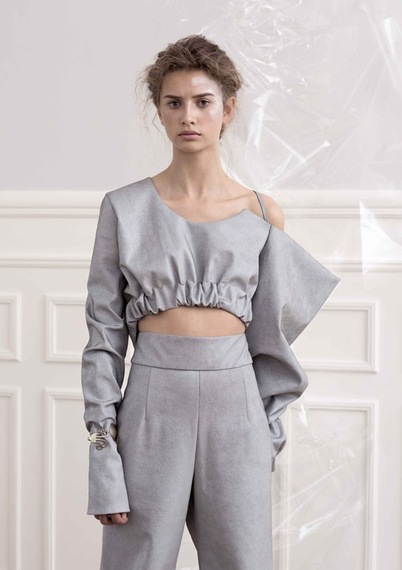
As this article goes to print I read a piece by Richie Siegel about the expected future domination of Amazon Fashion, despite its current lack of curation and aesthetic appeal to fashion shoppers - a problem now being addressed. Amazon's pricing model is not based on large margins and sales discounting to shift stock like traditional fashion retailers. Its margins are small, prices are keen and products are produced to fill gaps in the market - an already more 'sustainable' and pragmatic model - where a t-shirt costing £5 to produce is sold to consumers at around £6.50, in contrast to a traditional retailer who would squeeze suppliers down to a price of closer to £2 in order to sell to the consumer at £6.50. Since Amazon would potentially sell tens of thousands of units (based on it's market penetration and 65 million worldwide subscribers) it follows that if the products created by Amazon were sustainably and ethically produced it could trigger a big shift in the current polluting, inefficient, land-fill creating fast fashion sector. Granted, this still may result in a lot of product eventually finding its way to land-fill, but the business model and the motivations are promising, especially if cleaner production methods are employed, and the customer is at the centre of this model. For more information about calculating the cost of fast fashion, see my previous article Fashion Data: Calculating the cost of the fashion machine.
Martine is a curious and impassioned designer with a rich educational background (she gained a BA/MA at the Royal Danish Academy of Fine Arts in Copenhagen and did a stint at Rhode Island School of Design where she studied sculpture, artistic anatomy and anthropology amongst other broader fine art and design subjects, and has always worked in a cross-disciplinary manner. She feels that the solutions and impetus for the change needed in the fashion industry to achieve a level of responsible, sustainable manufacturing will come from outside the industry and that technology will most likely find the solution. Amazon is a technology company, and as mentioned above, looks set to disrupt fast fashion and provide some solutions to production excess and bloated inventories.
Martine and I discuss current examples of big brands tackling sustainability and I mention the Nike Flyknit trainers, manufactured using a single knitting process creating the upper with minimal wastage - no leather tanning and sewing of component layers is required - and it can be manufactured anywhere in the world as it is machine driven. This knitted upper began as a running shoe style and has now been used in a vast array of styles including the classic Air Force One and Nike Air Max. Hershel have recently released their 'ApexKnit' range of backpacks using the same knit technology and other product lines will surely follow. Digital knitting provides a solution that creates superior design, comfort, wearability and sustainability. Maybe that's the key. The sustainability looks like a bonus here, as the design and product performance is enhanced AND the product is sustainable. It is also cheaper and easier to develop and iterate, therefore creating a far superior solution to the old leather, fabric and foam uppers made of many components requiring man power for stitching and assembly.
Martine mentions being inspired by Nike's presentation at the Copenhagen Fashion Summit in which they explained the commercial and sustainable success of FlyKnit, achieved through technology and innovation. Martine later clarifies that Nike displayed a rare level of honesty at the summit, expressing frustration with the slow pace of change towards sustainability in the fashion industry. She happens to be wearing a pair of flyknit trainers during our interview, along with a gorgeous pinky, fleshy shimmering silk peaked slash neck blouse from her AW15 collection.
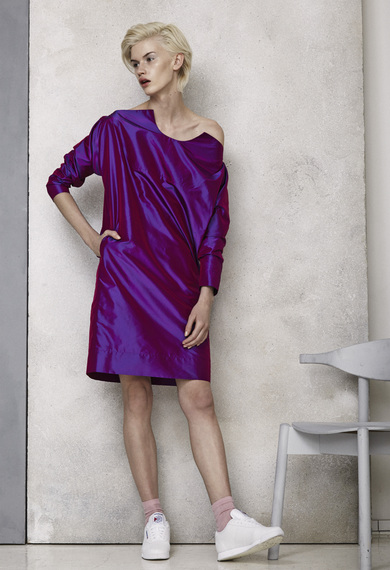
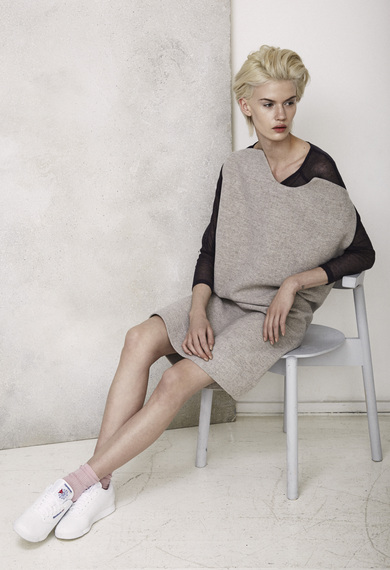
We discuss luxury fashion in this context and when Martine mentions the apparent lack of desire for true innovation in this sector our discussion leads to a lack of cross-disciplinary teams in luxury fashion and a persistent uniformity and conservatism. Where a team's perspective is limited, perhaps the resulting creative expression through product is too. It's difficult to find varied perspectives on solutions to creative problems if every team member has a similar professional experience and background, which tends to be the case in the luxury fashion sector.
Since launching her brand, Martine has used a combination of sustainable, recycled and surplus fabrics from luxury mills in Italy. Her design philosophy is to create garments with a lifespan beyond one season, that are made to the highest quality, with a minimal aesthetic and an element of the unexpected. She explores the tension between minimal and maximal so that her pieces have a personality and cites sculptural three dimensional creation of the garments as a driver for the silhouettes.

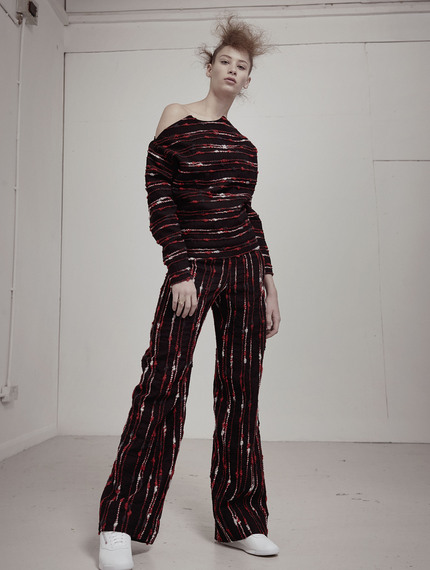
Martine's SS17 collection will launch at London Fashion Week on September 17th with a mixed reality experience using Hololens, in collaboration with DoubleMe, who provide a novel 3D capture system, HoloPortal, that converts 2D videos into dynamic 3D models in real-time and supported by the Fashion Innovation Agency. Hololens is a headset that projects a hologram in front of the wearer and allows them to interact with it by walking around it and moving nearer or farther, giving a truly immersive and personal experience dictated by the wearer. Martine's collection will be presented via Hololens, meaning technically, it could be viewed by anyone in any location who possesses the headset, and physically in an accompanying garment presentation at the W Hotel London, marking the first ever holographic 3D mixed reality fashion 'show' for want of a more appropriate word. So why this rather than a fashion show? The fashion show format has barely changed since its inception in the early 1900's and does not allow any kind of personal experience with the clothes - it is passive - as is much of the interaction in the way fashion is presented. There is a lack of true engagement when sat at a distance viewing clothes zoom past on a runway and in a matter of minutes, the whole experience is over. The format of a fashion show is also restrictive in that there is an intense build-up and planning and a huge team required to deliver a show to very tight deadlines within a remit that can curb the creativity of the designers and restrict the selection of garments shown, as outlined in a recent interview with London-based designers Fyodor Golan.
Martine found complete synergy with Hololens because it allows her to work across disciplines with their digital team and create a 3D experience befitting her sculptural design approach. Here, the presentation format is symbiotic with her design approach and affords her the opportunity to showcase that and tell a story which can then be navigated from the viewer's perspective, making another leap forward in our journey to the experiential as a form of fashion presentation. Crucially, her buyers are "super-excited" about the presentation format. Fashion is changing, albeit slowly, and it feels like Martine is at the foot of what will ultimately be the crest of an experiential fashion wave. She plans to work with this technology for coming seasons, declaring that this is in no way a one-off, but rather the beginning of an exciting journey to differentiating her brand in an intelligent and meaningful way and raising awareness of her successful creation of sustainable luxury fashion.
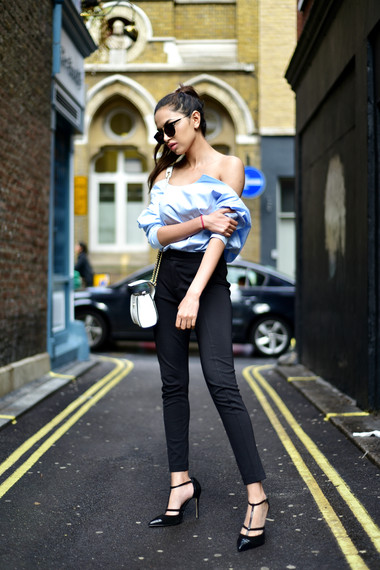
For details of Martine's previous collaboration with Alcantara SpA click here
Follow Martine on Twitter and Instagram
For information on first forays into fashion design using Hololens, click here
For a run down of fashion's exploration of VR to date, read Emma Hope Allwood's piece on Dazed Digital
Follow Techstyler on Instagram
First published on Techstyler.fashion
This September The Huffington Post UK Style is focusing on all things sustainable, for the second year running. Our thirst for fast fashion is dramatically impacting the environment and the lives of thousands of workers in a negative way. Our aim is to raise awareness of this zeitgeist issue and champion brands and people working to make the fashion industry a more ethical place.
We'll be sharing stories and blogs with the hashtag #SustainableFashion and we'd like you to do the same. If you'd like to use our blogging platform to share your story, email ukblogteam@huffingtonpost.com